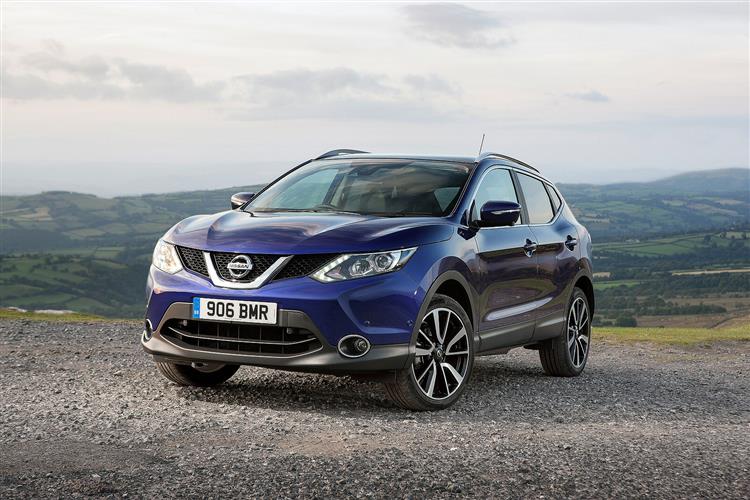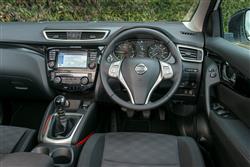QASH BACK (some text hidden) --NONE--
By Jonathan Crouch
Introductionword count: 74
Back in 2014, with over two million sales of its original Qashqai Crossover model on the board, Nissan went all-out to keep this second generation version ahead of an increasingly competitive chasing pack. Hence it's positioning as a bigger, classier, more practical, cleverer, quieter, better equipped and more efficient contender in the quickly growing family hatch-based family SUV market. British designed and built, this model makes a lot of sense as a used buy.
Modelsword count: 10
5dr Hatch (1.2 DIG-T, 1.6 DIG-T, 1.5 dCi, 1.6 DCI)
Historyword count: 347
Mention Nissan to most people and they'll think of a Japanese car maker. Nothing particularly remarkable. But ask industry experts about the company and they'll tell you a different story. Nissan is the manufacturer that made the most audacious gamble in recent automotive history - and it's one that paid off. The vehicle they went all-out on? This one right here, the Qashqai, a model that back in 2014, was rejuvenated in second generation guise. This version had quite an act to follow, the MK1 model having been credited with nothing less than a re-invention of its brand and the creation of the new market category we now know as the Crossover segment. Back at the original launch in 2007, the Qashqai was revolutionary, at last a new option for families shopping above the small car sector and looking for a versatile and relatively affordable runabout. People who had previously been restricted to mundanity - Focus-sized family hatches, Mondeo-style medium range models or, for the more daring, compact versions of small 4x4s or MPVs. Nissan's brilliance was in deciding to create a design that brought together elements of all these models into one sharply-styled, affordable and ever-so-desirable package. In doing so, the modern Crossover vehicle was born. Today, this class of car is something car makers launch to sell alongside their existing family hatchback and medium range contenders. Nissan, in contrast, took the much riskier step of completely replacing the models it offered in these segments with the Qashqai line-up, hoping to sell around 100,000 units a year. In the event, double that number reached global buyers and this turned out to be the most profitable vehicle in the company's history. With this replacement MK2 design, Nissan was disinclined to gamble again, so instead, this second generation Qashqai took the same qualities that made the original version such a winner in the Crossover class and refined them. It sold until the Spring of 2017 when a substantially upgraded version of this second generation model was introduced. Here though, our focus is on the 2014 to 2017-era models.
What You Getword count: 1441
When it came to the design of this second generation Qashqai, Nissan knew that it didn't need to re-invent a winning formula. So, in just the same way that a MK7 Volkswagen Golf of this era was merely a smarter evolution of its predecessor, so it is here, with a compact gym-toned shape that's 47mm longer than its predecessor but only fractionally wider. It sits a little lower too, which is surprising, for the higher-set driving position of the original MK1 version was something that women in particular said they especially liked about it. Fortunately, there's still enough high-set SUV-ness about this Nissan's appearance to satisfy most of them as part of the familiar sleek, poised stance. This MK2 model's extra length partly explains why Nissan decided not to offer a 7-seater variant as part of the second generation model line-up to replace the previous 7-seat 'Qashqai+2' model. The Japanese brand reckoned that most buyers who went for the first generation '+2' variant did so to get a larger boot rather than the extra seats, an additional luggage space requirement that this evolved Qashqai was better able to satisfy without the need for separate bodyshapes. For those who did still want seven seats, Nissan offered its pricier X-Trail SUV model. Those for whom five seats were quite sufficient took quickly to this MK2 Qashqai model though, liking the way that it was a more mature, assured-looking thing that was clearly well-engineered without having to adopt try-hard aesthetic flourishes to attract attention. The sporty looks went down well too, as did the faster, more elegant effect offered by the longer roof with its neat trailing rear spoiler, the lowered ride height and the way the bigger wheels smartly filled their arches. The design features real tension in the rear haunches, giving the effect of a car about to spring forward, while the rear features a sharp set of tail lights and a neat diffuser below the curvier bumper. Up-front, buyers were treated to a corporate Nissan V-shaped grille flowing back into a clamshell bonnet with impressively slim panel gaps, along with smart curves and swage lines. Under the skin, the sophisticated multi-link rear suspension that underpinned the original version of this car was ditched on 2WD models in favour of a simpler, lighter (and cheaper) torsion beam suspension set-up. Nissan insisted that the idea of this was to save weight, an approach that certainly worked. Thanks both to this and this model's hi-tech 'CMF' (or 'Common Module Family') platform, the second generation version of this car proved to be around 80kgs lighter than its predecessor. The cabin design was smarter, sharper and more up to date too. Nissan realised here that while customers were often seeking a touch of the Serengetti when it came to the exterior styling, tough, durable SUV-ness was less welcome to them once they got behind the wheel. So the workaday dash of the original Qashqai was jettisoned here in favour of a completely car-like interior that made much use of glossy plastic, metallic highlights and electronic toys, with all the most frequently used controls being just that little bit nicer to use than they were before. Plus it was soon clear that everything had been decently screwed together by the British Sunderland factory too. The overall result wasn't enough to give the prestige German brands any sleepless nights, but at the kind of prices being asked, that was an unreasonable expectation. The main instrument panel was a major element of this more expressive design. Visually, it was styled to expand the width of the cockpit and flows into the contoured door panels, creating a focus point at the centre for the all-important infotainment display screen and offering a cosseted feel that Nissan hoped would make passengers feel better protected. To emphasise that, the lower section of the dashboard features padded panels, along with additional pads on the centre console for the knees. The centre-dash TFT infotainment screen was provided in 5-inch form on base derivatives but on plusher models, it was delivered with the larger 7-inch screen of the NissanConnect navigation and communication system, cleverer and more informative in this MK2 model. As well as operating the usual audio, trip computer and Bluetooth 'phone functions, this set-up can tell you stuff like weather, traffic information and fuel prices plus, amongst other things, find you the most efficient route, score the green-friendliness of your driving or offer you Google 'Send-To-Car' technology so that you can plan your route on your PC before you go, then forward the instructions on to your Qashqai. Google's Point of Interest search system is also included, as well as access to things like weather forecasts, local fuel prices and flight information. Plus, if you're in a car whose original owner specified the 'Around View Monitor', this screen will display a 360-degree 'helicopter view' overhead image to simplify tight parking manoeuvres. That might be a little complicated to get your head around, but fortunately, the remainder of the cabin functions don't require an extended session with your nose buried in the vehicle handbook. The twin-dial instrument layout you view through the three-spoke leather-trimmed steering wheel is simplicity itself, with much of what you need to know delivered by a clear, classy colour TFT display set between speedo and rev counter. Practicalities have also been carefully considered, with a large glovebox and plenty of cubbies for swallowing odds and ends, with extra storage space created by the addition of an electric handbrake switch that frees up the centre console for some decently-sized cup-holders which are extra-deep so that bottles don't get in the way of your arm when you're changing gear. There are lots of lovely detail touches like that. Another, for example, is the way the centre storage box between the seats has been designed to shut properly, even when there's a wire poking into it charging up your 'phone. Not quite so good is the way that, further down, the bonnet release and fuel filler cap releases are positioned right next to each other. Most importantly, this is certainly a very comfortable place to be, something due in no small measure to the beautifully shaped seats, developed using medical scanning techniques inspired by the NASA space programme said to optimise blood flow in the lower back. We can't be quite as enthusiastic about the chairs provided for rear seat folk. These feature a lack of under-thigh support suggesting a design for kids rather than adults. Still, elsewhere in the back, the news is mostly good. Though the seats still don't slide or recline, they do offer a lot more space for your legs - nearly as much, Nissan claimed, as was provided in the old extended 'Qashqai +2' model. This MK2 design got a bit more shoulder room too, though still not quite enough to make long distance carriage of three adults an especially comfortable experience. You might have some concerns about headroom given this car's low-ish roof height but actually, it's not too bad - though can be compromised if the model you're looking at is fitted with the optional large, panoramic glass roof. Though, as you'd expect, this gives the interior a light, airy feel, it does lower the ceiling height a little. And out back? One of the other weaknesses of the original Qashqai was the restricted size of its luggage bay. Raise the tailgate and you'll find a 430-litre cargo area 20-litres bigger than the MK1 model could manage. To put that into perspective, we're talking a bit more than you get from rivals like Skoda's Yeti or Mitsubishi's ASX. But notably less than is offered by competitors like first generation versions of the Peugeot's 3008 or Mazda's CX-5. Helping the general usability of the overall boot area is the really useful luggage board system you get providing you avoid a base-trimmed model. It's made up of two reversible floor panels that can be easily raised or lowered, providing 16 possible configurations, whether your need is to slide in a mountain bike over a flat floor or prevent the contents of your weekly shopping from spreading themselves around the boot. To deal with the latter issue, you'll want to slot the board into the kind of vertical position that creates an ideal space for carrying shopping bags. The boards themselves feature a wipe-clean surface on one side and soft carpet on the other, perfect for transporting muddy boots or dirty dogs. If you do need more room, pushing forward the split-folding rear bench frees up 1,585-litres of total fresh air, far more than the previous generation model could offer.
To see the full road test text contact us on 0330 0020 227
Pictures (high res disabled)

.jpg)
|
.jpg)
|
.jpg)
| |||
.jpg)
|
.jpg)
|
.jpg)
| |||
.jpg)
|

|
Scoring (subset of scores)
Category: Crossover or SUV 4x4s
| Performance | |
| Handling | |
| Comfort | |
| Space | |
| Styling, Build, Value, Equipment, Depreciation, Handling, Insurance and Total scores are available with our full data feed. | |



